#Collared flycatcher
Text






the collared flycatcher is a small passerine bird found from southeast europe to the balkan peninsula and ukraine, migrating to spend winters in sub-saharan africa. as their name implies, they are agile birds that often catch insects on the wing, though they also feed on caterpillars and berries. males have a stark contrast between primarily black coloring with sharp white accents, while females and juveniles have a pale brown-grey color (though they also have similar white markings).
859 notes
·
View notes
Text
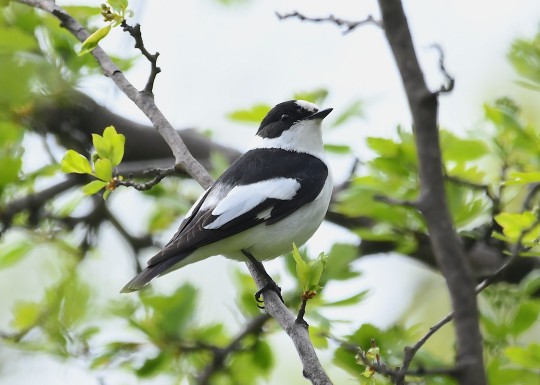
[2545/11080] Collared flycatcher - Ficedula albicollis
Order: Passeriformes
Suborder: Passeri
Superfamily: Muscicapoidea
Family: Muscicapidae (old world flycatchers)
Subfamily: Saxicolinae (chats)
Photo credit: Василий Калиниченко via Macaulay Library
#birds#Collared flycatcher#Passeriformes#Passeri#Muscicapoidea#Muscicapidae#Saxicolinae#Ficedula#birds a to z#undescribed
138 notes
·
View notes
Text
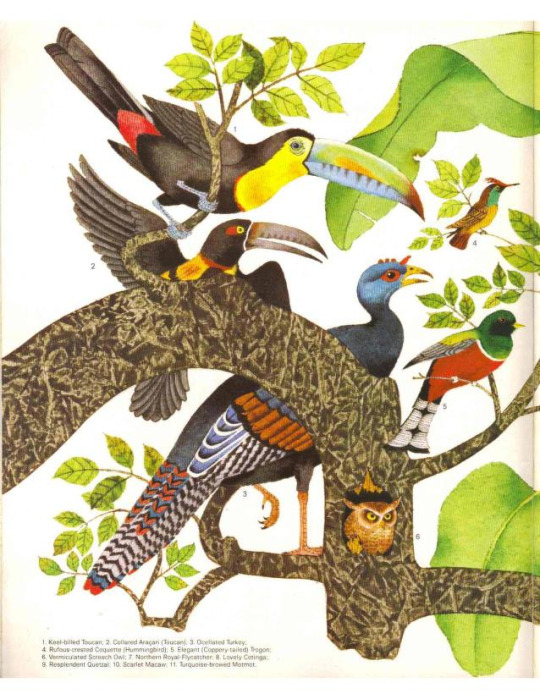

Ranger Rick's Nature Magazine; November 1979 edition.
Internet Archive
#birds#toucans#keel billed toucan#collared aracari#turkeys#ocellated turkeys#hummingbirds#rufous-crested coquette#trogons#elegant trogons#resplendent quetzal#raptors#owls#vermiculated screech owl#northern royal flycatcher#lovely cotinga#parrots#macaws#scarlet macaws#motmots#turquoise-browed motmot
317 notes
·
View notes
Text

A female black-naped monarch or black-naped blue flycatcher (Hypothymis azurea) in Tehatta, India. The black-naped monarch or black-naped blue flycatcher is a slim and agile colourful passerine bird found in tropical forest habitats of southern and south-eastern Asia. The male has a distinctive black patch on the back of the head and a narrow black half collar, while the female is duller with olive-brown wings and lacks the black markings on the head. These little birds are hard to find because they roam the forest at ground level in dim light to catch insects and hide behind leaves
Photograph: Soumyabrata Roy/NurPhoto/Shutterstock
#soumyabrata roy#photographer#nurphoto#shutterstock#black-naped monarch#monarch#bird photography#black-naped blue flycatcher#flycatcher#hypothymis azurea#tehatta#india#nature
29 notes
·
View notes
Text
I guess it's time I share my list of birds from this past Jewish year (I've been keeping two Big Year lists, Jewish year and secular year). All are from the US, except the last few which are indicated.
1. Ruby-crowned kinglet
2. American Robin
* Leucistic American Robin
3. Song sparrow
4. Rock pigeon
* Melanistic rock pigeon
5. Chipping sparrow
6. Hairy woodpecker
7. Mourning dove
8. Northern flicker
9. Eastern towhee
10. White crowned sparrow
11. White-throated sparrow
12 Savannah sparrow
13. House sparrow
14. European starling
15. American Crow
16. Common Raven
17. Gray catbird
18. Northern mockingbird
19. Canada Goose
20. Spotted Sandpiper
21. American herring gull
22. Marsh wren
23. Limpkin
24. Great white heron
25. Cattle egret
26. Anhinga
27. Snowy egret
28. Great blue heron
29. Black-crowned night heron
30. Wood stork
31. Common gallinule
32. Blue-gray gnatcatcher
33. Turkey vulture
34. Black vulture
35. Yellow rumped warbler
36. Tufted titmouse
37. Little blue heron
38. White ibis
39. Cooper's hawk
40. Cardinal
41. Green heron
42. Carolina wren
43. Palm warbler
44. Pine warbler
45. Sandhill crane
46. Carolina chickadee
47. Bluejay
48. Osprey
49. Chimney swift
50. Red-tailed hawk
51. Prairie warbler
52. American kestrel
53. Glossy ibis
54. Pied-billed grebe
55. Double-crested cormorant
56. Grey kingbird
57. Brown pelican
58. Fish crow
59. Royal tern
60. Bald eagle
61. Painted bunting
62. American white pelican
63. Common grackle
64. Boat-tailed grackle
65. Great-tailed grackle
66. American purple gallinule
67. American coot
68. Brown-headed cowbird
69. Tricolored heron
70. Mallard
71. Black-bellied whistling duck
72. Eastern kingbird
73. Yellow-billed cuckoo
74. Muscovy duck
75. American bittern
76. Ring-billed gull
77. American Pekin
78. Mallard-Pekin hybrid
79. Eastern bluebird
80. Yellow-bellied sapsucker
81. Red-winged blackbird
82. White-eyed vireo
83. Mottled duck
84. Broad-winged hawk
85. Dark-eyed junco
86. Brown thrasher
87. Sharp-shinned hawk
88. House finch
89. Eastern Phoebe
90. Downy woodpecker
91. Fox sparrow
92. Loggerhead Shrike!!!!
93. White breasted nuthatch
94. Red-bellied woodpecker
95. Brown creeper
96. Pileated woodpecker
97. American goldfinch
98. House wren
99. Barn swallow
100. Tree swallow
101. Black and white warbler
102. Red eyed vireo
103. Yellow warbler
104. Mute swan
105. Rusty blackbird
106. Common yellowthroat
107. Warbling vireo
108. Northern waterthrush
109. Veery
110. Swamp sparrow
111. Wood duck
112. American redstart
113. Orchard oriole
114. Greater Yellowlegs
115. Lesser Yellowlegs
116. Baltimore oriole
117. Hermit thrush
118. Wood thrush
119. Ovenbird
120. Indigo bunting
121. Black-throated blue warbler
122. Scarlet tanager
123. Worm-eating warbler
124. Northern rough-winged swallow
125. Blue-headed vireo
126. Northern parula
127. Prothonotary warbler
128. Philadelphia vireo
129. Blackburnian warbler
130. Magnolia warbler
131. Cedar waxwing
132. Blackpoll warbler
133. Yellow-throated vireo
134. Eastern wood pewee
135. Acadian flycatcher
136. Tennessee warbler
137. Caspian tern
138. Laughing gull
139. Forster's tern
140. American oystercatcher
141. Green-winged teal
142. Purple Martin
143. Least tern
144. Field sparrow
145. Killdeer
146. Grey-cheeked thrush
147. Rose-breasted grosbeak
148. Great-crested flycatcher
149. Swainson's thrush
150. Bay-breasted warbler
151. Chestnut-sided warbler
152. Willow flycatcher
153. Ruby-throated hummingbird
154. Peregrine falcon
155. Hooded crow IL
156. Laughing dove IL
157. Eurasian collared dove IL
158. Eurasian jackdaw IL
159. Common myna IL
160. Rose-ringed parakeet IL
161. White spectacled bulbul IL
162. European bee eater IL
163. Chukar IL
164. Short toed snake eagle IL
165. White stork IL
166. Little egret IL
167. Pygmy cormorant IL
168. Eurasian hoopoe IL
169. Alpine swift IL
170. Graceful pinia IL
171. Eastern Olivaceous Warbler IL
172. Tristan's Starling IL
173. Fan tailed raven IL
174. Eurasian black cap IL
Here's to at least 200 next year!
33 notes
·
View notes
Text

Collared flycatcher or Muscicapa collaris
The collared flycatcher is a small passerine bird in the Old World flycatcher family, one of the four species of Western Palearctic black-and-white flycatchers.
Available now on Redbubble
#flycatcher#bird#educational#nature#redbubble#vintage#biodiversity#vintage illustration#vintagrafica#artists on tumblr#encyclopedia#birdwatching
7 notes
·
View notes
Text
Week of 11Feb2024 Answers

Answers hidden under the cut.
85 - Surfbird by @sixhole
86 - Vermilion Flycatcher by @bl4ckbox
87 - Eurasian Collared-Dove by @inkkyte
88 - Slaty-tailed Trogon by @birbbro
89- Western Gull by @13flowersandfoxes
90 - Loggerhead Shrike by @satellite-juice
91 - Caspian Tern by Anonymous
How many birds did you get right? Consider adding correct birds to your WTB Life List!
As always, birding is a cooperative experience. Help your fellow birders out by discussing key features that help identity and distinguish a bird in the notes.
Finally, let's give a feathery thank you to this week's submitters.

Keep the game alive! Submit a bird HERE
15 notes
·
View notes
Text
okay, birds seen at home in june round up! comes to a total of 62 species, which is oddly high for the middle of winter. the highlight was the green twinspot, which i’d only got my first ever sighting of two weeks earlier. presumably it had only found its way to our garden because of the heavy rains and flash floods (and the tornado what the fuck) a few days prior - they’re forest birds, whereas our area is more broad-leaf woodland.
full list and photos under the cut!
bar-throated apalis, black-collared + crested + white-eared barbet, cape batis, dark-capped bulbul, green-backed camaroptera*, yellow-fronted canary, fork-tailed drongo, crowned eagle*, southern black flycatcher, african dusky flycatcher, african paradise flycatcher (odd for this time of year), egyptian goose, gymnogene, southern hadeda, purple-crested loerie. speckled mousebird, black-headed oriole, rose-ringed parakeet*, black-backed puffback, red-capped robin-chat, cape glossy + black-bellied + red-winged starling, collared + greater double-collared + olive + amethyst + white-bellied sunbird, olive + kurrichane thrush, golden-rumped tinkerbarbet, southern black tit, spectacled + village weaver, cape white-eye, cardinal + golden-tailed woodpecker, red-eyed + tambourine* dove, brown-hooded kingfisher, red-backed + bronze mannikin, klaas’s cuckoo*, lesser honeyguide, grey-headed bushshrike*, familiar chat, southern grey-headed sparrow, woolly-necked stork, sombre greenbul*, green woodhoopoe, cape wagtail, southern boubou, black sparrowhawk, african palm swift, green twinspot, black cuckooshrike?, black-headed heron, little sparrowhawk?, pied crow, african goshawk
* = call heard, no visuals, ? = i’m reasonably sure it was that, but not 100%

dark-capped bulbul, taken at a nature reserve up the hill

eurytela dryope

not sure yet. maybe a mocker swallowtail judging by the body?
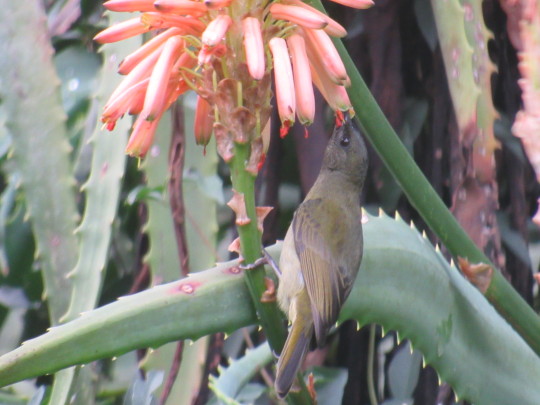
olive sunbird my beloved
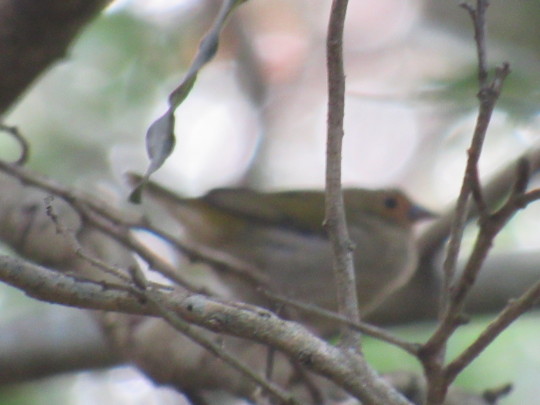
the green twinspot!! absolutely not a great photo, but i was surprised to get a pic at all tbh. either a female or juvenile
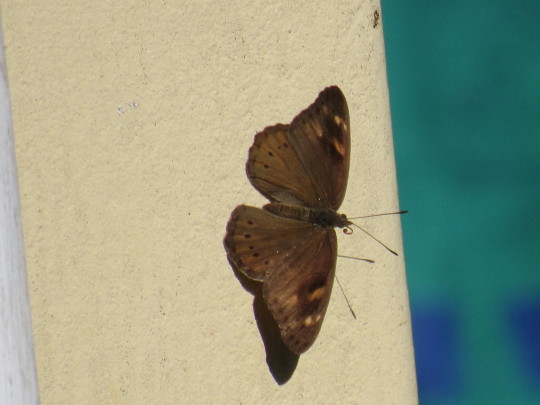
bosduival’s tree nymph

souther hadeda. chicken sized rats and the worst dawn chorus you’ve ever heard
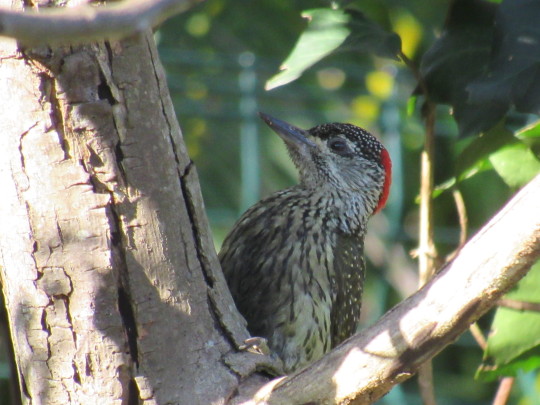
golden-tailed woodpecker
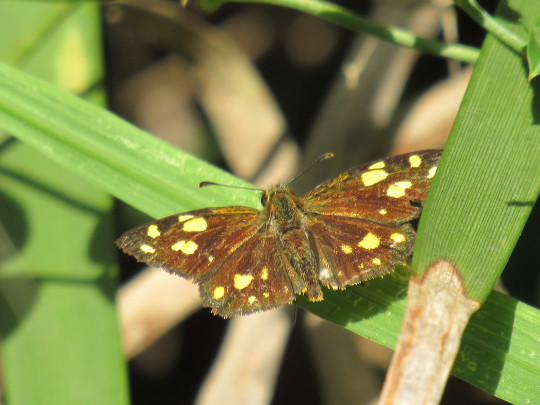
gold-spotted sylph. have never seen one before in my life, but it was hanging around the laundry
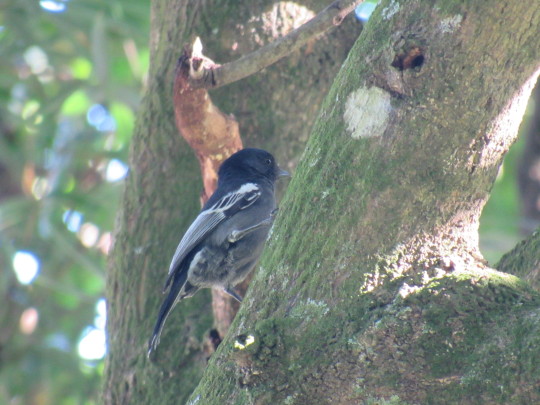
southern black tit!
#fieldnotes#birds#on birds#does tumblr have a birdwatching community tag#birding#birdwatching#bird watching
26 notes
·
View notes
Text
Masterpost (Round 2)
(Edit: these polls have all concluded)
Bracket: Faves
Pygmy Nuthatch vs Oilbird
Bonin Petrel vs Great Bustard
White-throated Magpie Jay vs African Penguin
Dusky Seaside Sparrow vs Yellow-billed Magpie
Prothonotary Warbler vs Channel-billed Cuckoo
Pallas' Sandgrouse vs American Dipper
Blakiston's Fish Owl vs Pinyon Jay
Common Ground Dove vs Toulouse Goose
Bracket: Pretty Birds
Lady Amherst's Pheasant vs Japanese Paradise Flycatcher
Pink-necked Green Pigeon vs Plumed Whistling Duck
Pink Robin vs Red-cheeked Cordonbleu
Southern Emuwren vs Painted Redstart
Wilson's Bird-of-Paradise vs Bohemian Waxwing
Violet Turaco vs Purple Honeycreeper
Golden Pheasant vs Pompadour Cotinga
Purple-crowned Fairy vs Bluethroat
Bracket: TRUE hipsters
Emerald Starling vs Zigzag Heron
Kaua'i Mole Duck vs Whiskered Auklet
Madagascar Ibis vs Red-crested Turaco
Water Thick-Knee vs Palawan Peacock-pheasant
White-tailed Ptarmigan vs Regent Honeyeater
Invisible Rail vs Cabot's Tragopan
Collared Nightjar vs Kagu
Palau Kingfisher vs Sickle-winged Nightjar
Bracket: FOUR
Bat Hawk vs Hamerkop
Fiery-billed Aracari vs Bell Miner
Ancient Murrelet vs Arabian Babbler
Spotted Forktail vs Groove-billed Ani
Hairy Hermit Hummingbird vs Wedge-tailed Eagle
European Shag vs Short-tailed Pygmy Tyrant
Streaked Weaver vs Oriental Bay-Owl
Bearded Bellbird vs Marvelous Spatuletail
#hipster bird main bracket#bracket: pretty a#bracket: true a#bracket: four a#bracket: fave a#bracket: fave b#bracket: pretty b#bracket: true b#bracket: four b#bird polls#animal polls#information#not polls#masterpost#round 2
14 notes
·
View notes
Text
Carlos: Rating the birds in my backyard by tendency toward violence.
Carlos: Northern cardinal, 4/10. I'm sometimes worried the male is sexually harassing the female but I'm pretty sure they're just doing some elaborate public pickup roleplay. The rest of us didn't agree to participate in your kink, guys.
Carlos: American robin, 1/10. Literally just some dude hanging out. Never bothered anyone but worms. Big fan of the way you just stand there in the middle of the grass like you forgot what you were supposed to be doing.
Carlos: House sparrow, 10/10. You're a gang. You're participating in gang violence. There's ten billion of you living in a single wood pile and it's been civil war for three years now. When will the bloodshed end?
Carlos: Tufted titmouse, 1/10. A shy baby. A pretty little guy. I saw you on the neighbor's garage roof and time stopped. There were anime sparkles around you. Come back.
Carlos: European Starling, 9/10. Why is it always you? Listen, I know, I KNOW the sparrows are the problem, and YET. When the fighting starts, it's always you in the middle of it, provoking them and then screaming like you're an innocent bystander defending yourself. I'm onto you.
Carlos: Carolina Wren, 3/10. This rating is not for physical violence, which you don't engage in, but for your role as an incurable narc. A tattle tale. I know they're fighting again, okay? I see it. Our yard has been a warzone for years, you don't have to make a big announcement every time someone misbehaves.
Carlos: Eastern wood-pewee, 0/10. If this were "birds who think they're better than everyone else," you'd get 10/10.
Carlos: Red-bellied woodpecker, 6/10.It's a utility pole. It's not a tree. You're surrounded by trees that are full of bugs. But there you are, on the utility pole. Committing vandalism.
Carlos: American crow, unrated. For who am I to cast judgment on the actions of La Famiglia? I assume you are doing what is best for the neighborhood. If I could, though, without criticism, make a single observation. That when large numbers of you gather in the ominous dead cottonwood - no? No, you're right. None of my business.
Carlos: Great crested flycatcher, 5/10. Frankly, I think you could be doing more. I think your name implies a great potential. I think you should massacre the insects. I think your beak should drip with viscera.
Carlos: Common grackle, 7/10. La Famiglia does not suffer you to stop in our neighborhood long, and I trust their judgement in this manner. You have the look of a guilty bird.
Carlos: Tennessee Warbler, 2/10. You keep to yourselves, and I respect that. I get the sense that you could defend yourselves if it came to it, though.
Carlos: Brown-headed cowbird, 3/10. You're not a crow, and eventually they ARE going to figure it out, kiddo.
Carlos: Gray catbird, 5/10. Would you. Respectfully. Would you shut the FUCK UP.
Carlos: Eurasian collared-dove, 0/10. You're doing great, sweetie, everyone loves you.
Carlos: Red-breasted nuthatch, 4/10. A comedian. A little jester of a bird. You're so silly. Sure sometimes you incite violence in others but, really, is that your fault? If it is, we forgive you.
Carlos: Blue jay, 12/10. If you could learn any human behavior you wanted, it would be how to build a bomb.
Carlos: Honorable mention: Turkey vulture, 5/10. You weren't in my backyard, but you WERE eating roadkill in the street in my neighborhood. I know the animal was already dead when you got there, but you get violence points for frightening the small children that walked past you. Incredible work.
(original post)
3 notes
·
View notes
Note
Name every bird
Abbott's babbler
Abbott's booby
Abbott's starling
Abd al-Kuri sparrow
Abdim's stork
Aberdare cisticola
Aberrant bush warbler
Abert's towhee
Abyssinian catbird
Abyssinian crimsonwing
Abyssinian ground hornbill
Abyssinian ground thrush
Abyssinian longclaw
Abyssinian owl
Abyssinian roller
Abyssinian scimitarbill
Abyssinian slaty flycatcher
Abyssinian thrush
Abyssinian waxbill
Abyssinian wheatear
Abyssinian white-eye
Abyssinian woodpecker
Acacia pied barbet
Acacia tit
Acadian flycatcher
Aceh bulbul
Acorn woodpecker
Acre antshrike
Acre tody-tyrant
Adamawa turtle dove
Adelaide's warbler
Adélie penguin
Admiralty cicadabird
Afep pigeon
Afghan babbler
Afghan snowfinch
African barred owlet
African black duck
African black swift
African blue flycatcher
African blue tit
African broadbill
African citril
African collared dove
African crake
African crimson-winged finch
African cuckoo
African cuckoo-hawk
African darter
African desert warbler
African dusky flycatcher
African dwarf kingfisher
African emerald cuckoo
African finfoot
African firefinch
African fish eagle
African golden oriole
African goshawk
African grass owl
African green pigeon
African grey flycatcher
African grey hornbill
African grey woodpecker
African harrier-hawk
African hawk-eagle
African hill babbler
African hobby
African hoopoe
African jacana
African marsh harrier
African olive pigeon
African openbill
African oystercatcher
African palm swift
African paradise flycatcher
African penguin
African piculet
African pied hornbill
3 notes
·
View notes
Text
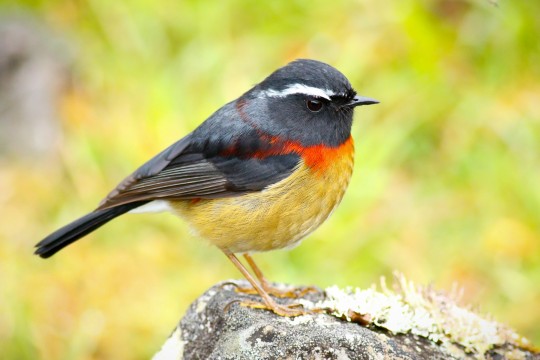
[2540/11080] Collared bush robin - Tarsiger johnstoniae
Order: Passeriformes
Suborder: Passeri
Superfamily: Muscicapoidea
Family: Muscicapidae (old world flycatchers)
Subfamily: Saxicolinae (chats)
Photo credit: u7 Liao via Macaulay Library
#birds#Collared bush robin#Passeriformes#Passeri#Muscicapoidea#Muscicapidae#Saxicolinae#Tarsiger#birds a to z#undescribed
253 notes
·
View notes
Text
state facts of oklahoma
state motto labor omnia vircit-labor conquers all things
only capital with oil well directly underneath it
only state produces iodine and helium
shopping cart invented
red river 1290 miles
accada oklahoma worlds largest sculpture pop bottle
1st tornado warning
longest lighting flash 199.5 miles long
oklahoma city zoo in 1902
state capital oklahoma city and largest city
state size 69,898 sq miles
population 4,019,800
state hood 11-16-1907
highest point black mega 4975ft
lowest point little river at arkansas border 289ft
length 465 miles
width 230 ft
state nickname sooner state
famous people 5
state tree redbud
state amphibian bullfrog
state bird scissor tailed flycatcher
state butterfly black swallowtail
state furbearer animal racoon
state fish white bass
state fruit strawberry
state fossil saurophoganax maximus
state flower oklahoma rose
state flying mammal mexican free tailed bat
state game bird wild turkey
state insect honey bee
state reptile collared lizard
state veegetable watermelon
state wild flower indiana blanket
0 notes
Text
3 Local Favorites Birdwatching Spots Around Palm Springs
Birdwatching or "birding" is an inexpensive hobby you can take up anywhere and anytime. And to start, you only need three things: a bird guide, binoculars, and a birding destination. Grab your binoculars and get ready for a day of birding excursions in the best birdwatching spots around Palm Springs. Take advantage of the top three birdwatching spots around Palm Springs to guarantee a spectacular birdwatching adventure. Top 3 Go-to Birdwatching Spots Around Palm Springs Prescott Preserve 1801 E Sunny Dunes Rd - (760) 385-8255 Start your day surrounded by nature and wildlife in the Prescott Preserve. It's still under restoration and will include an expansive butterfly garden and habitats for mammals, birds, bees, and more. Native plants and trees will occupy the preserve along with designated areas for birdwatching, biking, or walking. Locals boast of the different species of birds they found, namely Vermilion Flycatcher, Egyptian Goose, Green Heron, and more. Prescott Preserve is a real bird lover's paradise and a fantastic place for birdwatchers to catch the most mesmerizing bird species. Demuth Park 4200 E Mesquite Ave - (760) 320-6430 Demuth Park is bringing out all the birds in the yard, with approximately 25 species to watch and observe. The park's lush greenery and waters provide the perfect environment for our feathered friends. Meanwhile, the paved walkway gives visitors ample space to observe and take pictures of the birds in their natural habitat. Enjoy your morning walk basking in the sunshine or admire the breathtaking view of the nearby mountains. Demuth Park is one of the best spots for birdwatchers because of its accessibility to the various species of birds. You can catch all sorts, from the Mourning Dove and Eurasian Collared-Dove to Costa's Hummingbird and Great Blue Heron. There's also a pond serving as a home to several water birds, like the Canada Goose, American Coot, etc. You can also stand by the bird feeder station, which serves as an attraction for the birds. Take unique photographs and document your birding experience in one of the best birdwatching spots around Palm Springs. Palm Springs Aerial Tramway (888) 515-8726 Level up your birdwatching experience and ride on the Palm Springs Aerial Tramway while scouting for mountain and local birds. The ride provides an exhilarating experience for visitors as they ascend to Mt. San Jacinto State Park. It gives a scenic view of the mountain ranges and is also one of the top birding spots. The mountain station's wide viewing area gives you a unique view of the wilderness. Home to several bird species like Mountain Chickadee, Western Bluebird, Steller's Jay, Violet-green Swallow, and so much more. A bird viewing guide is also available in the station, which is great for helping out first-time birdwatchers identify the bird species they encounter. Overall, Palm Springs Aerial Tramway is an excellent spot for birdwatching, suitable for beginners and seasoned birders alike. Geoffrey Moore is Your Palm Springs Area Real Estate Expert Would you like to see more of GeoffreyMoore.com? Please click here for our blog page. Please click here for our "About Us" page to learn more about my team. Thanks for visiting
Originally published here: https://www.geoffreymoore.com/blog/3-local-favorites-birdwatching-spots-around-palm-springs.html
0 notes
Photo

البرقش الأوربي الاسم الانجليزي : European Stonechat الاسم العلمي : Saxicola rubicola البرقش او القليعي شبه المطوق طائر صغير يعيش في آسيا وأوروبا وإفريقيا . وللذكر رأس وعنق سوداوان ، وأجزاؤه السفلى كستنائية اللون ، أما أنثاه فهي باهتة اللون . وطائر القليعي المطوق متحفز ، نشط ، ويعيش عادة في الأماكن المكشوفة كثيفة الأعشاب ، ويبني عشه على الأرض تحت باقة أعشاب ، ويأكل يرقات الحشرات والديدان والخنافس والبذور ============ @boyahia ============ The European stonechat (Saxicola rubicola) is a small passerine bird that was formerly classed as a subspecies of the common stonechat. Long considered a member of the thrush family Turdidae, genetic evidence has placed it and its relatives in the Old World flycatcher family Muscicapidae. The stonechat is 11.5–13 cm long and weighs 13–17 g, slightly smaller than the European robin. Both sexes have distinctively short wings, shorter than those of the more migratory whinchat and Siberian stonechat. The summer male has black upperparts, a black head, an orange throat and breast, and a white belly and vent. It also has a white half-collar on the sides of its neck, a small white scapular patch on the wings, and a very small white patch on the rump often streaked with black. The female has brown upperparts and head, and no white neck patches, rump or belly, these areas being streaked dark brown on paler brown, the only white being the scapular patch on the wings and even this often being buffy-white. (at محمية شرق الجهراء للطيور) https://www.instagram.com/p/CkGocjFqX6W/?igshid=NGJjMDIxMWI=
0 notes
Photo
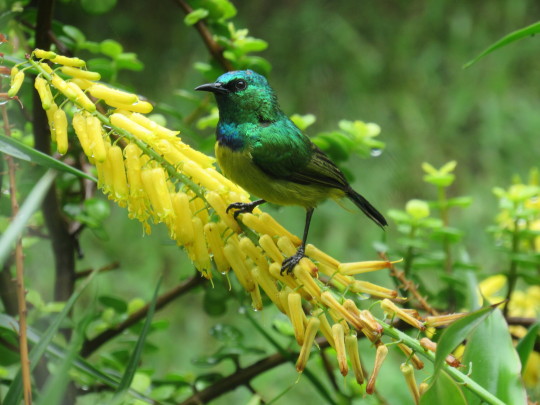

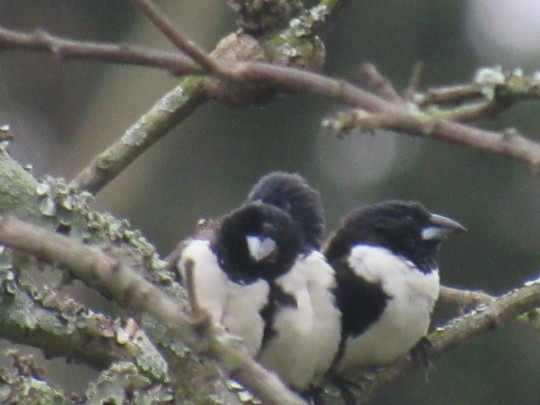
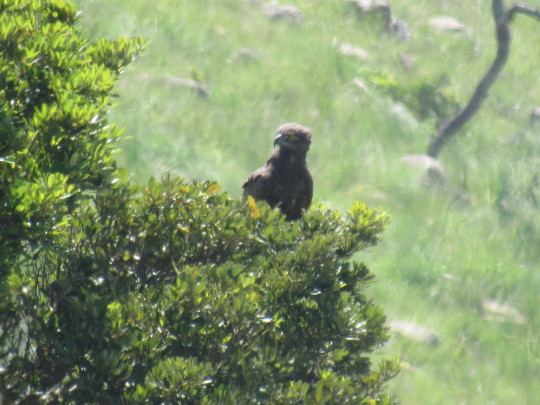

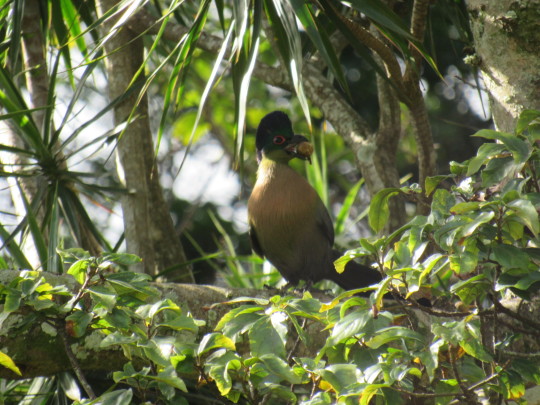
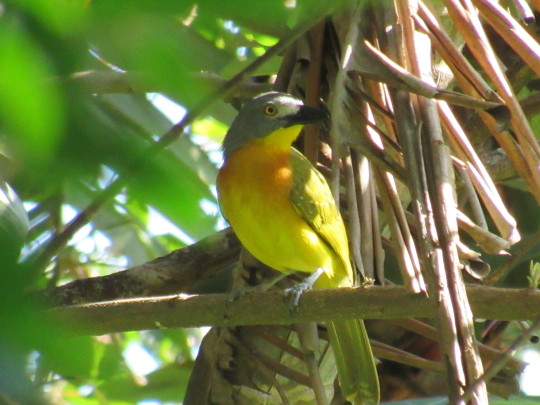
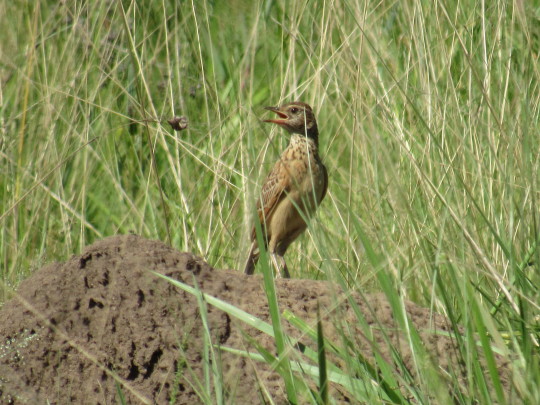
january's bird round up! from left to right, collared sunbird, common buzzard, magpie mannikins, brown snake-eagle, african harrier-hawk, purple-crested turaco, grey-headed bush-shrike and rufous-naped lark
new bird species seen this month are ashy flycatcher, rufous-naped lark, willow warbler, magpie mannikins
#special shout out to the brown snake-eagle and scaly-throated honeyguide i saw at a local reserve#photos are better when viewed full size#on birds#diary
24 notes
·
View notes